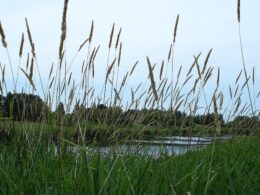About Deer Grass (Muhlenbergia Rigens)
Deer grass (Muhlenbergia rigens) is a warm-season perennial grass that is native to California, New Mexico, Texas, and Mexico. It grows in clumps and has long, arching leaves. The foliage is usually green in the spring and summer, and turns golden-brown in the fall.
This grass blooms in the summer, and the flowers are pinkish-red on 5-foot tall spikelets. Deer grass is an important cover for mule deer and a food source for many birds species. It’s also used by humans for landscaping, erosion control, and as a biofilter. Because it helps to stabilize the soil, deer grass is often planted on hillsides and in areas that are prone to wildfires.
Deergrass in Xeriscape Gardens
Deer grass is a beautiful and versatile plant that can be used in many ways. It’s perfect for xeriscape gardens, as it requires very little water once it’s established. This hardy plant can tolerate drought, heat, and poor soils. Deer grass is an excellent choice for hillsides, slopes, and other difficult-to-grow areas in your garden.
Deer grass also makes a great accent plant. Its long leaves add movement and texture to the landscape. And, when it’s in bloom, it adds color and interest to your garden. It looks much like pampas grass, although it’s less showy.
Do Deer Eat Deer Grass?
If you’re wondering how deer grass relates to deer, the answer is: in a useful way! The young shoots of the plant are a favorite food of deer. However, older plants are unpalatable for them, so you don’t need to worry about your deer grass being eaten. In fact, it will direct deer’s attention away from your other plants, while staying untouched itself. Isn’t that amazing?
How to Plant and Care for Deer Grass
Deer grass is easy to grow from seed, plug, or division. It’s a fast-growing grass, so you’ll see results quickly. Once it’s established, this grass is drought-tolerant and low-maintenance. It doesn’t need to be mowed, and it’s not susceptible to pests or diseases.
Planting Site
This grass grows best in full sun, but it will tolerate some shade. It prefers well-drained soils, but it can also survive in areas with periodic flooding. Deer grass is also salt-tolerant, making it a good choice for coastal gardens.
Spacing
When planting deer grass, space the plants 5 feet apart. If you’re growing it in mass plantings, you can plant them 3-4 feet apart. Deer grass will spread quickly, so be sure to give it plenty of room to grow.
Watering
Once deer grass is established, water it deeply once a week during the summer. If you live in a hot, dry climate, you may need to water it more often. In the winter, this grass is dormant and doesn’t need to be watered.
Fertilizing
You can add compost to the soil around the plants. This will help to keep deer grass healthy and looking its best. However, don’t fertilize it with commercial fertilizers, as this can cause the plants to become leggy.
Pruning
Deer grass can be pruned in the spring to remove any dead or damaged leaves. You can also cut it back to 6-10 inches above the ground to encourage fresh growth.
Find Muhlenbergia Rigens Deer Grass in Your Local Nursery
In conclusion, deer grass is a beautiful, versatile, and low-maintenance plant that is perfect for xeriscape gardens. It’s also deer-resistant once established, which makes it a great choice for deer-prone areas. So, if you’re looking for a plant that is easy to grow and care for, this is a great option. You should easily find it in a local nursery – enjoy the California native in your garden!
Do you have any questions about deer grass? Leave a comment below, and we’ll be happy to answer them. Happy gardening!



















